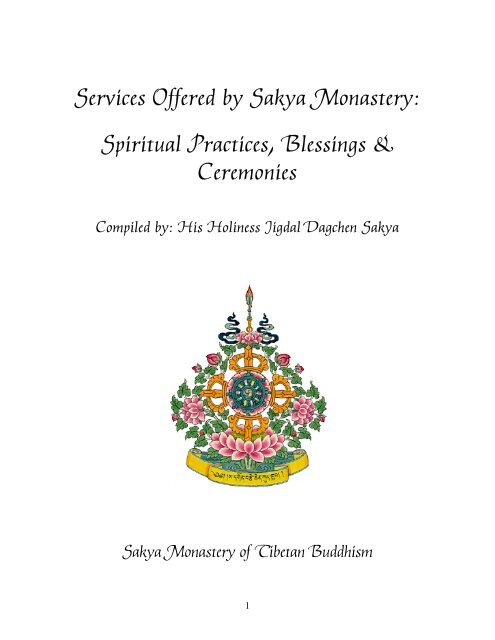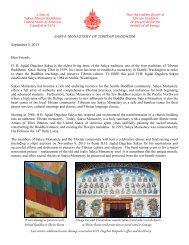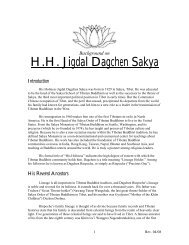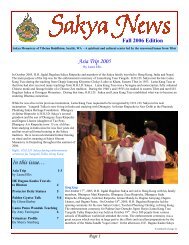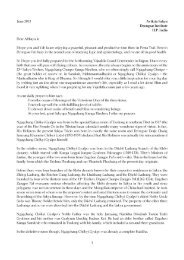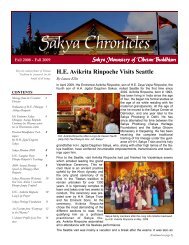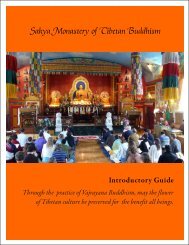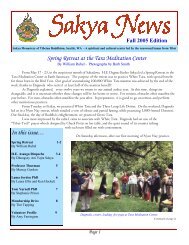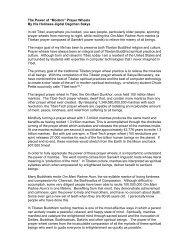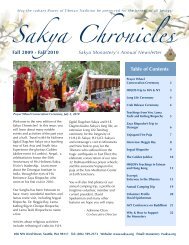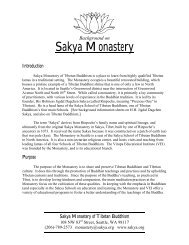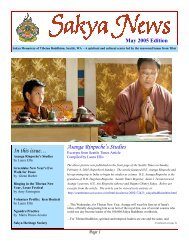Services Offered by Sakya Monastery: Spiritual Practices, Blessings ...
Services Offered by Sakya Monastery: Spiritual Practices, Blessings ...
Services Offered by Sakya Monastery: Spiritual Practices, Blessings ...
You also want an ePaper? Increase the reach of your titles
YUMPU automatically turns print PDFs into web optimized ePapers that Google loves.
<strong>Services</strong> <strong>Offered</strong> <strong>by</strong> <strong>Sakya</strong> <strong>Monastery</strong>:<strong>Spiritual</strong> <strong>Practices</strong>, <strong>Blessings</strong> &CeremoniesCompiled <strong>by</strong>: His Holiness Jigdal Dagchen <strong>Sakya</strong><strong>Sakya</strong> <strong>Monastery</strong> of Tibetan Buddhism1
Published <strong>by</strong>:<strong>Sakya</strong> <strong>Monastery</strong>108 N.W. 83 rd StreetSeattle, WA 98117 USAPhone: 206-789-2573Fax: 206-789-3994Email: <strong>Monastery</strong>@sakya.orgURL: http://www.sakya.orgCompiled <strong>by</strong>:H.H. Jigdal Dagchen <strong>Sakya</strong> RinpocheH.E. Dagmo Kusho <strong>Sakya</strong>Edited <strong>by</strong>:Chuck PettisGillian TeichertAdrienne ChanMichelle Neubauer©2009 <strong>Sakya</strong> <strong>Monastery</strong> of Tibetan Buddhism2
Table of ContentsIntroduction.................................................................................................................................................4Becoming a Buddhist ..................................................................................................................................5Maturing Your Mind through Vajrayana Practice .................................................................................6Deity Initiations ........................................................................................................................................6Group Request for a Deity Initiation........................................................................................................7<strong>Blessings</strong> for New Life ................................................................................................................................8General Ba<strong>by</strong> Blessing .............................................................................................................................8Ba<strong>by</strong> Blessing Which Includes Hair Cutting Ceremony and Bestowal of a Dharma Name: For theChild of a Buddhist Practitioner ..............................................................................................................8<strong>Blessings</strong> for Weddings...............................................................................................................................9Wedding Protocol...................................................................................................................................10Wedding Registration Form ...................................................................................................................11<strong>Blessings</strong> & Consecrations for Places & Objects ...................................................................................12Land, Home, Business or Store ..............................................................................................................12Statues, Stupas, Thangkas, Malas, Prayer Flags, and Religious Objects ..............................................13<strong>Practices</strong> for Healing, Relieving Suffering & Mourning .......................................................................14Dedication of Merit at the <strong>Monastery</strong> ....................................................................................................14Elaborate Dedication of Merit at the <strong>Monastery</strong> with Samantabhadra Prayer and Food Offering(Mang-cha) .............................................................................................................................................16Medicine Buddha Prayer Circle.............................................................................................................17Shitro Practice: Prayers for the Deceased.............................................................................................18Sur The Complete 49-Day <strong>Spiritual</strong> Practice as Described in “The Tibetan Book of the Dead” (BardoThodol) for Loved Ones Who Have Passed............................................................................................19<strong>Practices</strong> for Removing Obstacles: Green Tara Prayers .......................................................................20Astrology Chart Reading .........................................................................................................................20Divination – “Chak-Mo” ..........................................................................................................................22Retreats ......................................................................................................................................................233
SAKYA MONASTERY OF TIBETAN BUDDHISMIntroduction<strong>Sakya</strong> <strong>Monastery</strong> of Tibetan Buddhism has compiled this spiritual practices guidebook to assistpeople who are interested in integrating Buddhist beliefs into their daily lives. For furtherinformation or to request any of the practices outlined in this guidebook, please contact AdrienneChan (executive director) at monastery@sakya.org or call Monday through Friday 8:00 a.m. tonoon at (206) 789-2573.Note: Please make suggested donations to <strong>Sakya</strong> <strong>Monastery</strong> of Tibetan Buddhism. Donations aresuggested price ranges. Give at the level at which you are able. See Adrienne Chan if you haveany questions.4
Becoming a Buddhist: Taking RefugeWhat is taking refuge?Taking refuge is the gateway to the Buddhist path of liberation. It is a formal ceremony duringwhich one becomes a Buddhist. One takes refuge in the Three Jewels or the Triple Gems; theBuddha, the Dharma, and the Sangha. Taking refuge involves a wholehearted commitment toyour spiritual path as well as a desire to benefit all sentient beings. If you are interested inlearning more about taking refuge, please see our V.E.I. catalogue for the date of the next“Significance of Taking Refuge” class.Why does one take refuge?There are a variety of valid reasons for becoming a Buddhist (traditionally referred to as “takingrefuge”). The reasons can be reduced to three motivations. The first is fear of being trapped insamsara (the endless round of births and deaths) as well as the fear of ignorance, desire andaversion. The second reason is faith or supreme confidence in the Three Jewels: the Buddha, theDharma and the Sangha. The third motivation is compassion, benevolence, and the desire toalleviate all beings’ suffering. In the Vajrayana tradition (which is what we practice at <strong>Sakya</strong><strong>Monastery</strong>), one seeks liberation for all sentient beings.The refuge ceremony procedurePlease feel free to invite your family and friends to observe this auspicious occasion.In appreciation for the gift of refuge, you will be making the following offerings:1. At the beginning of the ceremony, you will offer to the Shrine (representing the Buddha)one ceremonial scarf (katag) and either flowers, incense, candles or a monetary offering(monetary offering may be of any amount that you feel comfortable giving).2. When you receive your blessing cord, you will offer a ceremonial scarf (katag) and amonetary gift offering of appreciation to the Lama. At this time you will receive your newDharma name from the Lama.3. At the conclusion of the ceremony, please present monetary gift offerings of appreciationto the Translator and to the Ordained Attendant(s).The refuge prayer is recited in Tibetan after the Lama during the ceremony, and the meaning isas follows; All the Buddhas and Bodhisattvas of the ten directions please pay attention to me, (say yournew Dharma name).Until enlightenment is attained, I take refuge in the Buddha, the best of bipeds, I takerefuge in the Dharma, free of desire, and I take refuge in the Sangha, the accumulation of merit andwisdom.If you wish, after the refuge ceremony you are welcome to join in the following; A group photograph is taken with the Head Lama, the monks, the translator, and yournewfound Dharma brothers and sisters. Meet with <strong>Sakya</strong> <strong>Monastery</strong> ambassadors to ask questions and learn more about the<strong>Monastery</strong>. You, your friends and family, and the ambassadors may meet downstairs in the Tibetancultural hall to enjoy tea and fellowship. In the next week there will be an evening follow-up class (Life With Refuge: Building aBuddhist Life).If you have questions about the refuge ceremony, want to sign up for the next refuge ceremony,or have any questions after the ceremony contact <strong>Sakya</strong> <strong>Monastery</strong>’s office.5
Maturing Your Mind through Vajrayana PracticeDeity InitiationsWhat is a Deity Initiation?Initiations are special ceremonies in which the Lama acts as a conduit between yourself and thedeity, transmitting blessings and authorizing you to perform meditational practices specific tothat deity.Why does one request an initiation?Certain practices require an initiation as a prerequisite. For example, at <strong>Sakya</strong> <strong>Monastery</strong> eachmonth we do practices such as Mahakala, White Tara, Medicine Buddha, and Shitro which allrequire a deity initiation. Even if a practice does not have an initiation prerequisite, having aninitiation strengthens the practice and enables one to practice it at home. To see examples of pastinitiations please feel free to peruse the initiation binder in the <strong>Sakya</strong> <strong>Monastery</strong> Cultural Hall.Procedure for requesting an initiation1. The request and sponsoring donation for an initiation may be made <strong>by</strong> an individual or group(for a group request, please see page 7).2. Offer a katag in a vertical manner to the Lama to indicate a request for teachings or aninitiation.3. A letter or note requesting the initiation along with the donation should be in an envelopeaccompanying the katag.Responsibilities for an initiation1. Offering to Accompany Request – A $100 monetary offering with a katag is offered to theLama when requesting the initiation.2. Cho Do – A monetary offering of $20 is required one week before the initiation so that the<strong>Monastery</strong> assistant can buy materials: candles, incense, torma ingredients, etc.3. Fruit – The evening before the initiation, a bowl of fruit is required for the Lama’s table, toestablish the coming of an auspicious event.4. Gratitude – To express appreciation, at the conclusion of the initiation, katags and monetaryofferings are made to the Lama, ($150), each of the assistants ($25, usually three assistants)and the translator ($75).5. Initiation Deity’s picture, mantra, and/or Sadhana – Copies of the deity picture, mantraand/or Sadhana for the initiates.6
Group Request for a Deity InitiationResponsibility Sign-UpFor group requests, the financial and other responsibilities for requesting and sponsoring aninitiation can be shared as follows;Deity Initiation Being Requested: ________________________________$100 monetary gift to accompany katag requesting the initiation.Name Amount Email or phone1)2)Katag - $7 offering for the katag to accompany the initiation request.Name Amount Email or phone1)Cho Do - $20 offering to pay for candles, incense, torma ingredients, etc.Name Amount Email or phone1)Fruit bowl provided the night before the initiationName Amount Email or phone1)Make color copies of the Deity picture and copies of the spiritual practice.Name Amount Email or phone1)Gratitude – Katag and monetary offering made to Lama (Lama offering of $150)Name Amount Email or phone1)2)Assistants offerings of $25/eachName Amount Email or phone1)2)3)Translator offering of $75Name Amount Email or phone1)2)7
<strong>Blessings</strong> for New LifeGeneral Ba<strong>by</strong> BlessingWho performs the ba<strong>by</strong> blessing?The Lama performs the ba<strong>by</strong> blessing. He will recite prayers and give the child a sacred blessingcord and a long life katag.Why should one have a ba<strong>by</strong> blessing?A ba<strong>by</strong> blessing is beneficial for the following reasons; it brings about family happiness, ensureslong life of the child, and decreases obstacles for the child.Ba<strong>by</strong> Blessing Which Includes Hair Cutting Ceremony andBestowal of a Dharma Name:For the Child of a Buddhist PractitionerWho performs the ba<strong>by</strong> blessing?The Lama performs the ba<strong>by</strong> blessing. He will recite prayers, cut a lock of hair from the child’shead (which is symbolically offered to the Buddha), and give the child a sacred blessing cord anda long life katag.Why should one have a ba<strong>by</strong> blessing?A ba<strong>by</strong> blessing is beneficial for the following reasons; it brings about family happiness, ensureslong life of the child, and decreases obstacles for the child. After this ceremony the childbecomes a Buddhist and receives a Buddhist Dharma name.Please contact <strong>Sakya</strong> <strong>Monastery</strong> office at monastery@sakya.org for suggested donation.Note: Donations are suggested price ranges.8
<strong>Blessings</strong> for WeddingsBackground Information & What to BringCouples (Buddhist or non-Buddhist) can arrange to have their wedding ceremony officiated <strong>by</strong>our Head Lama, H.H. Jigdal Dagchen <strong>Sakya</strong>, at <strong>Sakya</strong> <strong>Monastery</strong> in the lower shrine room.Offsite marriage ceremonies may be performed <strong>by</strong> H.E. Jamyang Dagmo Kusho <strong>Sakya</strong>.For weddings held at <strong>Sakya</strong> <strong>Monastery</strong>, non-members need to contact the <strong>Sakya</strong> <strong>Monastery</strong>office to fill out a facilities use agreement.The couple should bring the following items;1. Marriage License2. Offering for the Buddha Shrine (i.e., flowers, fruits, incense or candles, etc.)3. Three katags4. Reception food/beverage for your guests plus plates, hot cups, and napkins5. If the marriage is at <strong>Sakya</strong> <strong>Monastery</strong>, as part of your wedding ceremony, <strong>Sakya</strong><strong>Monastery</strong> will provide auspicious Long Life rice and tea for the couple.Please see the following two pages for wedding protocol and the registration form. Thewedding protocol which follows applies for weddings taking place at <strong>Sakya</strong> <strong>Monastery</strong>. If youare interested in an offsite wedding, please contact Adrienne Chan for specific details.Please contact <strong>Sakya</strong> <strong>Monastery</strong> office at monastery@sakya.org for suggested donation.Note: Donations are suggested price ranges.9
Wedding ProtocolPlease seat yourself, leaving the first two rows for the families of the couple.When all the guests are seated, the Lama will enter the room, at which time everyone shouldstand.When the Lama has seated himself, everyone may sit down.The Lama will explain the wedding ceremony.The couple will stand, and the bride and groom will make three prostrations to the Shrine, andmake offerings to the Shrine with katag.The Lama will bestow blessings on the couple.The Purification Ceremony will be performed.The groom will make an envelope offering to the Lama on behalf of the couple with a katag.The Lama will then give katags to the couple.The couple will exchange rings.Auspicious rice and tea offerings will then be presented to the Shrine, Lama and couple.The Food Offering Prayer will be recited.The couple will toss some rice in the air three times as an offering, eat some rice themselves, anddrink some tea.The Lama recites the Long Life & Happiness Dedication Prayer.The Lama leaves.Family and friends may then offer congratulations and well wishes.Pictures may be taken throughout the wedding ceremony.10
Wedding Registration FormAfter reviewing the material, if you are interested in a wedding, please provide the requestedinformation below and return it to the address below. We will contact you within 2 weeks toconfirm a wedding date.Sincerely,Adrienne ChanExecutive DirectorWEDDING REGISTRATION FORMToday’s Date: _____/_____/_____Name(s):_________________________________________________________Address:_________________________________________________________________________________________________________________________Email: __________________________________________________________Phone Number: (____)______-___________For Tibetan astrological purposes, please provide your birthdays:1. _____/_____/_____2. _____/_____/_____Please provide 3 possible Sundays on which you would like your wedding, ranked from firstchoice to last choice. Also, indicate the desired time for each date (must be after 1:00 p.m.).1. _____/_____/_____2. _____/_____/_____3. _____/_____/_____11
<strong>Blessings</strong> & Consecrations for Places & ObjectsLand, Home, Business or StoreWhy should I have my land, home, or business blessed?The benefit of having a location blessed is that it creates harmonious energy, and generateshappiness, long life, enjoyment, and good health.Where is the blessing performed?The blessing is performed at the site which shall be consecrated.Who performs the blessing and what is the suggested donation?The blessing can be performed <strong>by</strong> any of the following individuals;Head Lama, H.H. Jigdal Dagchen <strong>Sakya</strong> + one attendantH.E. Jamyang Dagmo Kusho <strong>Sakya</strong> + one attendantVen. Tulku Yeshi Gyatso + one attendantMonk or nun + one lay attendantWhat is the procedure for having my land, home, or business blessed?The lama or ordained performing the blessing will need a ride to and from the location.Please pay half of the lama or monk/nun and attendant offering to <strong>Sakya</strong> <strong>Monastery</strong> prior to theblessing.For the blessing ceremony you need to provide the following items:1. A altar or a picture/statue/thangka of Buddha*2. Items to be placed on the shrine or in front of the picture of Buddha: flowers, candles,bowl of fruit, incense, etc.3. A clean bowl filled with uncooked rice4. Sticks of incense for the individual performing the blessing5. At the end of the blessing, please give the remaining half of the monetary offering to thelama or monk/nun and his/her attendant.*If you don’t have an altar, the lama’s attendant will bring altar objects for use in the blessing.Please inform in advance if this is the case.Please contact <strong>Sakya</strong> <strong>Monastery</strong> office at monastery@sakya.org for suggested donation.Note: Donations are suggested price ranges.12
<strong>Blessings</strong> & Consecrations for Places & ObjectsStatues, Stupas, Thangkas, Malas, Prayer Flags, and Religious ObjectsWhy should I have my statue or religious object blessed?It is not appropriate to leave “empty” religious objects such as statues or stupas on a shrine.Therefore, they must be filled. They are filled with “Tsung-Shu” which is a combination ofblessed and valued items such as relics, mantras, jewels, medicines, grains, etc. Other religiousobjects (such as your thangkas and malas) should be blessed to turn these empty objects intosacred objects.What is the procedure for having my statue or religious object blessed?You can bring your items to <strong>Sakya</strong> <strong>Monastery</strong> and leave them with the office staff anytimeMonday-Friday, 8:00 AM – Noon. Provide the office staff with your religious objects and theappropriate donation amount, and make sure to fill out the proper form (see below). You will benotified <strong>by</strong> phone or e-mail when the blessing is complete. <strong>Sakya</strong> <strong>Monastery</strong> is not responsiblefor lost or stolen items.Date: _____/_____/_____Number of statues: _______________Religious objects description:________________________________________________________________________________________________________________________________________________________________________________________________________________________________________________________________________________________________Name: ____________________________________________________________Contact phone or e-mail: ______________________________________________For office use onlyTsung Shu Fee Rcvd.: _______<strong>by</strong> (staff): _________________________________Donation to Lama Rcvd: _____________Donation to Monk Rcvd: _____________Please contact <strong>Sakya</strong> <strong>Monastery</strong> office at monastery@sakya.org for suggested donation.Note: Donations are suggested price ranges.13
<strong>Practices</strong> for Celebration, Healing, Relieving Suffering& MourningDedication of Merit at the <strong>Monastery</strong>What is a dedication of merit?When one does spiritual practices, they accumulate merit from having done that practice. Everyspiritual practice concludes with a dedication of merit. One can choose to dedicate that merit to aspecific individual for that individual’s benefit and the benefit of all sentient beings.Why do you do dedication of merit?Dedication of merit can be done to celebrate auspicious events or to relieve suffering. It can alsobe done as a mourning practice to help those who have passed away to accomplish a quick andsuccessful re-birth (for other mourning practices, please see the Shitro or Sur practices).Who do you do dedication of merit for?Dedication of merit can be done for anyone! You can dedicate merit to your loved ones,including pets or other animals.When is dedication of merit done?Dedication of merit prayer requests for an individual can be done during Thursday or SundayChenrezi.What is the suggested donation and what items are suggested for dedication of merit?According to Tibetan Buddhist tradition, in order for a blessing to be complete, one must makean offering to establish a personal connection with the Three Jewels and the recipient of themerit.1. Offering to altar (any amount) with a katag2. Offering to the lama (any amount) with a katag3. (Optional) $25 for rack of 100 candles to be lit on the day of the dedication of merit. ATibetan tradition is to light candles or butter lamps for the removal of obstacles. Candlesare also symbolic of the removal of the “darkness of ignorance”4. (Optional) Flowers or incense (symbolic of the removal of defilements)5. (Optional) Photograph of your loved oneWhen you arrive, inform a greeter that you wish to dedicate merit. He/she will let you knowtoward the end of the practice when it is time for you to take your offerings to the altar.How to dedicate merit• You will do three prostrations to the Buddha• Place a katag and offerings on the altar table• Make your katag and monetary offering to the lama & show the picture of your loved one• Make an incense offering provided <strong>by</strong> an ordained• State who we are dedicating our merit to and pass the picture around for the congregationto view• Return to your seat to partake in the prayers that will follow14
What should I do if I cannot come to <strong>Sakya</strong> <strong>Monastery</strong> in person, but still want to dedicatemerit?You may make an out-of-area dedication of merit request. The prayers will be done at theconclusion of one of the meditational practices within a week from the time we receive yourofferings. In lieu of your presence, a monastery representative will make your dedication of meritrequest according to the in-person procedure. If you send a photograph (optional), please send aself-addressed stamped envelope for returning the photograph to you. Please include a note withyour donation to explain what or who the donation is for.15
Elaborate Dedication of Merit at the <strong>Monastery</strong> withSamantabhadra Prayer and Food Offering (Mang-cha)One week advance notice required.What is an Elaborate Dedication of Merit ceremony?An elaborate dedication of merit ceremony includes elements from a standard dedication ofmerit, as well as the recitation of the Aspiration of Samantabhadra prayer and a Mang-cha.What is a Mang-cha?A Mang-cha is a food offering to the Three Jewels for their blessings and to the entirecongregation in appreciation for their prayers.When and where does the Mang-cha take place?After Sunday Chenrezi service, everyone is welcome to come downstairs to our cultural hall andenjoy the food offering (Mang-cha).Note: If you are bringing your own food for the Mang-cha, please contact <strong>Sakya</strong> <strong>Monastery</strong>Office.What is the suggested donation?1. Offering to altar (any amount) with a katag2. Offering to the lama (any amount) with a katag3. $200 for food offering (food for Mang-cha purchased <strong>by</strong> the <strong>Monastery</strong>). Please give thisdonation to Adrienne Chan. Alternatively, you may bring your own food, but pleaseensure that there is enough for 75 – 100 people.4. (Optional) $25 for rack of 100 candles to be lit on the day of the dedication of merit5. (Optional) Flowers or incense (symbolic of the removal of defilements)What should I do if I cannot come to <strong>Sakya</strong> <strong>Monastery</strong> in person, but still want to do anElaborate Dedication of Merit ceremony?You may make an out-of-area Elaborate Dedication of Merit ceremony request. The prayers willbe done at the conclusion of one of the meditational practices within a week from the time wereceive your offerings. In lieu of your presence, a <strong>Monastery</strong> representative will make yourdedication of merit request according to the in-person procedure. If you send a photograph(optional), please send a self-addressed stamped envelope for returning the photograph to you.Please include a note with your donation to explain what or who the donation is for.16
Medicine Buddha Prayer CircleWho is the Medicine Buddha?The Medicine Buddha is a transformation of Shakyamuni Buddha, who manifested as theMedicine Buddha in order to give Medicine teachings.Why request Medicine Buddha prayers?Medicine Buddha blessings alleviate suffering, sickness and injury, thus prolonging human lifeand improving the human opportunity to attain enlightenment. You can request MedicineBuddha prayers for a loved one or yourself who is ill.Who does the Medicine Buddha prayers and when does it take place?Medicine Buddha prayers are done on each new moon. The prayers are done <strong>by</strong> either a group oflay practitioners who have taken the Medicine Buddha initiation or an ordained at the <strong>Monastery</strong>.What is the procedure for requesting Medicine Buddha prayers?E-mail the person’s full name, a description of what the prayers are for, and a photograph(optional) so the group can visualize your loved one. Send your request to:monastery@sakya.org. Put “Medicine Buddha Prayer” in the subject line.Suggested DonationThe Medicine Buddha prayer circle is a service freely given <strong>by</strong> the lay members as part of theirpractice. You are welcome to make a small donation to the <strong>Monastery</strong> on your loved one's behalfif you would like.Special RequestsYou may also request that one of the ordained perform these prayers.Please contact <strong>Sakya</strong> <strong>Monastery</strong> office at monastery@sakya.org for suggested donation.Note: Donations are suggested price ranges.17
Shitro Practice: Prayers for the DeceasedWhat is Shitro practice?Shitro is meditation and practice for those that have passed away.Why request Shitro practice?In Buddhism, helping someone to die well is one of the most important gifts we can give anotherperson. If you have a loved one who has passed away, you can help them (even if it has beenmany years since their death), <strong>by</strong> having the Sunday morning Shitro group do prayers on theirbehalf.Who does Shitro and when does it take place?Shitro is done on Sunday mornings at 7:00 a.m. <strong>by</strong> a group of lay practitioners who havereceived the Shitro initiation. A Buddhist practitioner requesting the practice for a loved one canparticipate in the Shitro practice without the initiation.How long are Shitro prayers done for?The Shitro prayers are held for 8 consecutive Sundays. When the practice is concluded, thepictures or cards with the name and date of passing are burned and the ashes are placed in astream.What is the procedure for requesting a Shitro practice?E-mail the person’s full name, their date of passing, your name, and a photograph (optional) sothe group can visualize your loved one. Send your request to: monastery@sakya.org. Put “ShitroPrayer” in the subject line.Suggested DonationThe Shitro practice is a service freely given <strong>by</strong> the lay members as part of their practice. You arewelcome to make a small donation to the <strong>Monastery</strong> on your loved one's behalf if you wouldlike.18
SurThe Complete 49-Day <strong>Spiritual</strong> Practice as Described in“The Tibetan Book of the Dead” (Bardo Thodol)for Loved Ones Who Have PassedWhat is “Sur” and why does one request these prayers?Sur is the complete 49-day spiritual practice as described in “The Tibetan Book of the Dead.”Having Sur prayers done for someone who has passed away can be very beneficial for them inthe following ways;1. Facilitates person’s passage through the bardo.2. Purges attachment to objects.3. Helps to achieve harmony with local deities, nagas, formless spirits, and the spirits ofyour loved ones, including pets.Who performs this practice?Monk or nunWhere do the prayers take place?The prayers take place at <strong>Sakya</strong> <strong>Monastery</strong>.What do I need to provide?When making your request for this practice, please provide the deceased individual’s full name,age, date of passing, and a photograph. In addition, please provide 1 stick (¼ pound) of butterand a ½ pound bag of barley flour which will be used as an aromatic offering during the prayers.Please contact <strong>Sakya</strong> <strong>Monastery</strong> office at monastery@sakya.org for suggested donation.Note: Donations are suggested price ranges.19
<strong>Practices</strong> for Removing Obstacles: Green Tara PrayersWhat is the purpose of requesting Green Tara prayers?This practice is very useful and can help remove obstacles and negative forces for importantevents like a business meeting, a trip, an exam, etc. It can remove obstacles and help to “clear thepath” for property, home, business, or an individual.Who is Green Tara?Green Tara is a Tibetan Buddhist deity who embodies wisdom and compassion. Green Tararepresents enlightened activity and is the essence of all the 21 Taras of the Tibetan Buddhisttradition. She is the mother of all beings, goddess of the Earth and the heavens, connected on theouter level with the worlds of plants, animals and humans.Who performs these prayers?The practice is performed <strong>by</strong> a lama, monk, or nun.Please contact <strong>Sakya</strong> <strong>Monastery</strong> office at monastery@sakya.org for suggested donation.Note: Donations are suggested price ranges.20
Astrology Chart ReadingBackground information about Tibetan Buddhist astrologyThe Tibetan astrological system comes from the teachings of the Lord Buddha and has beenpracticed for centuries. According to the Tibetan tradition, personal astrological charts can beperformed annually, or for the past, present and future lives. People can learn from the chart oftheir past lives and decide what they should do in this life, and what they should do to improvetheir future lives. For couples planning a future together, their astrological charts can be read andmatched. For those who are in business, chart readings can provide them with guidance to makethe right decisions to succeed and prosper. Those who are planning to move into a new house canthe consult astrological charts for the best time to move in. The charts can provide instructionsfor those who are ill and suffer physically, to perform the appropriate healing prayers and rituals.The astrological charts can also guide the surviving family and friends of the deceased to engagein activities that will be beneficial to the deceased in the next and future lives.Who performs the astrology readings?Venerable Tulku Yeshi Gyatso performs the astrology readings. He has studied Tibetanastrology and divination from Lama Nomka Rinpoche and Lama Sonam at the Tashi Kyi<strong>Monastery</strong> in Amdo, Tibet. He has been doing astrological readings, including the Ling Gesardivination, for Tibetans and Westerners for many years.Who can receive Tibetan Buddhist astrology readings?Astrology readings can be done for those who have taken refuge.What kind of astrology readings can I receive, how long do they take, and what is thesuggested donation?Type of Astrological Chart Required Time Suggested Donation1. Annual 1 week $ 1002. Past, present & future lives 2 weeks $ 2003. Wedding 1 week $ 1004. Business 1 week $ 1005. Moving 1 week $ 1006. Healing 1 week $ 1007. Personal Deities for present and future lives 1 week $ 1008. Bestow Tibetan or Dharma name 1 week $ 1009. Most beneficial meditation practice for your life 1 week $ 10010. Your pets 1 week $ 100How do I request an astrology reading?You can request an astrology reading through the <strong>Sakya</strong> <strong>Monastery</strong> office phone (between 8:00AM and noon) or e-mail.What information do I need to provide?You should provide your name, gender, the year and month of birth, and the type of readingwanted. All information will be kept confidential.21
Divination – “Chak-Mo”What is Chak-Mo?Chak-mo (or Mo) is a divination technique used in Tibetan Buddhism using a mala or dice. Youmay bring important yes or no questions to the lama who will find a direct answer for you.Questions may range from issues surrounding the purchase or sale of a house to business, travel,marriage, or relationship decisions. Any doubt that you may want to resolve can be addressedthrough divination. In situations where there is sufficient information for an individual to makehis/her own decision, Mo should not be used as a way of avoiding responsibility.Who performs the divination?The divination is performed <strong>by</strong> the Lama.Please contact <strong>Sakya</strong> <strong>Monastery</strong> office at monastery@sakya.org for suggested donation.Note: Donations are suggested price ranges.22
RetreatsWhy do a retreat?In Tibetan Buddhism, there are two broad areas of formal religious activity. The first is teachingand the second is application. Usually, the teaching takes place at a <strong>Monastery</strong> and theapplication is performed during a retreat. The purposes of doing a retreat are as follows; Purification of body, speech, and mind, Deity practice for spiritual accomplishments and removing obstacles Helpful for obstacle year (every twelve years) Helpful for periods of bad luck There are some traditional Tibetan practices that are short (3 days) that areespecially good for laypeople, such as the fasting practice called Nyen Nay.Where does the retreat take place?The retreat takes place at Tara Meditation Center at Earth Sanctuary on Whidbey Island. Pleasesee http://www.sakya.org/Overview_Purpose.htm for more information about the center.What is the procedure to go on a retreat?Select the dates you wish to go on retreat and notify the <strong>Sakya</strong> <strong>Monastery</strong> office through email ortelephone. All retreats for monastery members need to be reviewed <strong>by</strong> H.H. Jigdal Dagchen<strong>Sakya</strong>. If the dates are available you will fill out the application and release form on the websiteat http://www.sakya.org/Rates_and_Reservations.htm. Send, fax, or bring in the application tothe <strong>Monastery</strong> office. Contact the <strong>Monastery</strong> for information on individual, group or extensiveretreats.How much does it cost to go on a retreat?For monastery members, the cost is as follows;Day retreats: $25/day/personOvernight stay: $35/night/person or $210/week/person23


